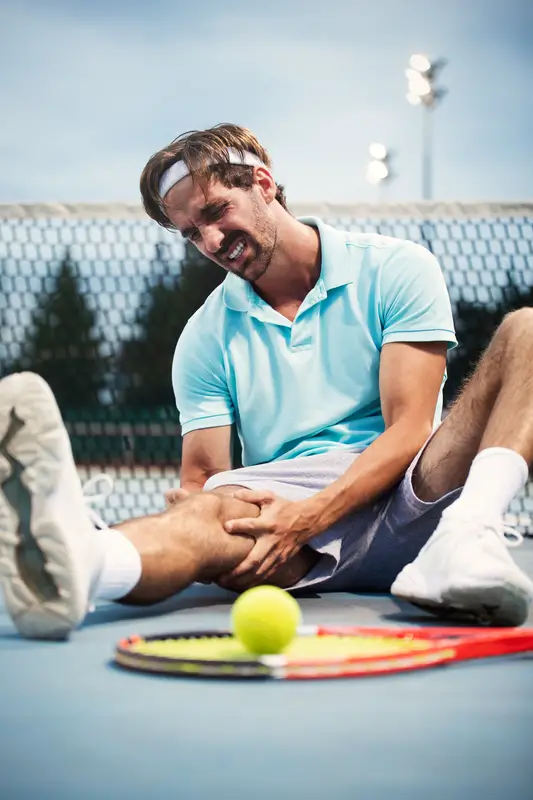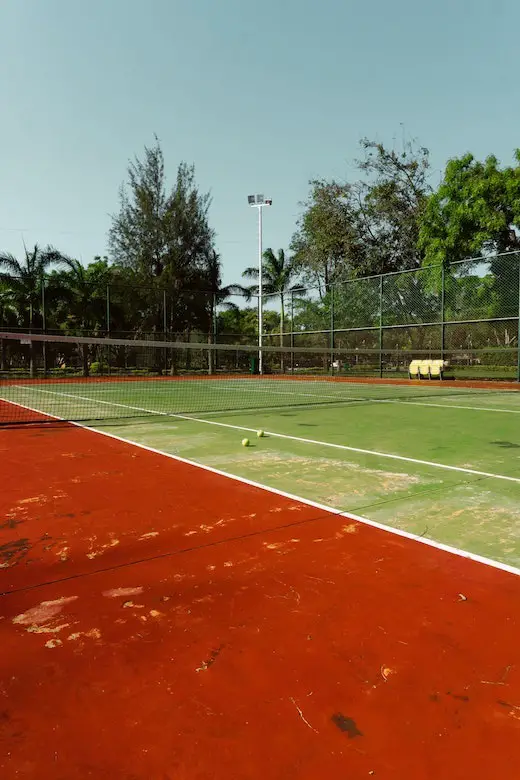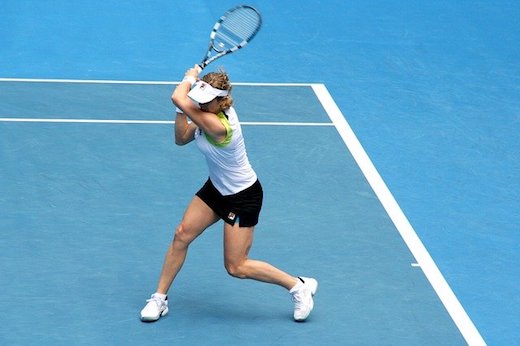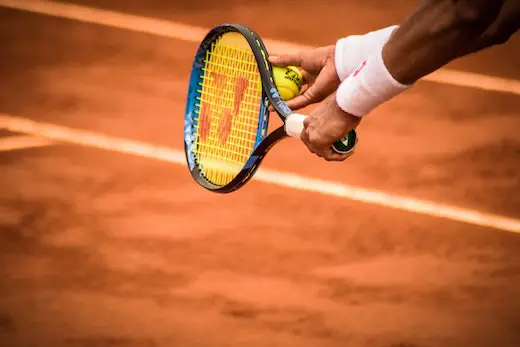- Shoulder – Usually Due to Serving and Overhead Motions
- Knee – Suffers From Heavy Impact
- Wrist – High Impact Zone When Striking the Ball
Your Guide
 Gavin Davison
Gavin Davison
Tennis is an extremely high-impact sport, much like others at the highest level.
The court surface can be unforgiving, especially on hard courts.

And with players needing to sprint from side to side, stop instantly, and twist on a dime, it goes without saying that your joints can take a fair beating.
All of this definitely takes its toll as you get older, trust me!
And as you can see above, the three joints that bear the brunt here include the shoulders, knees, and wrists.
I’ve had the displeasure of having a major shoulder injury in my time, and my wrist has flared up from time to time too.
Fortunately, I’ve not had too many problems with my knees.
But with that said, I’d still say I’m reasonably qualified to talk about the issues facing joint problems in tennis.
Nobody wants to get injured, of course, but it is simply a fact of the game that these things can
happen. This is also true for professional players.
We’ve seen Rafael Nadal and Roger Federer suffer from knee problems in recent years.
And even the superhuman specimen of Novak Djokovic has endured elbow and wrist injuries during his career.
So as you can see, injuries can strike us all, and I’d like to delve a little deeper on this topic right here.
Explanation of Why These Joints Get Injured Most
I’ve chosen not to list elbows as one of the main joints that get injured in tennis.
Besides the recurring issue of tennis elbow that certain players have, I’m not aware of too many players suffering from other elbow problems.
While I’m not saying that elbows don’t get injured besides tennis elbow, I’d say that the other three joints carry more significance in the injury department.
Why do I believe this to be the case?
Read on to find out.
(A) Shoulder Injuries
Shoulder injuries can vary greatly in terms of the UNDERLYING PROBLEMS.
Personally, I’ve had a long-standing impingement in my right shoulder.
This causes sharp pain when raising the arm above shoulder height, and unfortunately, it’s a problem I’ve dealt with most of my career.
But this is just one problem – there are countless others that can arise.
With the shoulder being a ball and socket joint, there are many things that can go wrong when playing tennis.
And while I’m not a qualified physio, I can tell you now that these problems mainly arise from overhead movements.
When someone has a shoulder injury, serving, overheads, and anything above shoulder height can be a real problem.
With the shoulder being involved in every stroke in tennis, it is tough to give this joint time to heal and rest too.
(B) Knee Injuries
While shoulder injuries arise from actually playing the game, knee injuries arise largely due to movement, instead of the act of hitting a tennis ball.
When you think about it, it makes PERFECT SENSE as to why the knees might get injured more than other joints.
Every single shot in tennis requires you to drive with your legs to a certain extent.
Serving requires that you bend and push up to the ball, groundstrokes require you to lift with the legs to get adequate upward motion through the shot….
…and even volleys require you to spring towards the ball.
Not only this, but tennis rallies can be PRETTY GRUELLING.
On a hard court, players must stop and change direction instantly, and players cover some serious ground throughout matches.
Nadal is a classic example, with his style of play being more of a grind on his body.
(C) Wrist Injuries
Much like the shoulder joint, your wrist is involved with every single stroke in tennis.
And if there is a weakness or some kind of inflammation there, believe me, you’ll feel it.
The pain can range from moderate to severe when contacting the ball, and wrist injuries can be rather crippling in general.
Take Dominic Thiem as an example – he has been away from the tour for a long time now with a wrist injury that JUST WON’T HEAL.
Bear in mind he will have access to the best physios and doctors around!
How to Protect These Joints on and off the Court
Although these three joints do bear a lot of the injuries sustained in tennis, there are ways to protect the joints.
Here are my top tips for doing so:
Shoulder – Strengthen and Restrict the Joint
The first thing you should think about here is how to strengthen the joint.
I’d recommend grabbing some of therabands to perform some exercises, every single day.
This video should help give you some ideas if you are stuck:
In addition to these exercises, you should try and restrict the joint when playing.
Depending on the injury, you might just strap the shoulder.
But if you want optimal support and restriction, you might want to tape the upper part of your back too.
Knees – Play With a Knee Support and Rest as Much as Possible
If your knee injury is severe, of course, your best option is to rest as much as possible.
There is no way of avoiding impact on the knees in tennis, unfortunately.
But if you are able to play and the pain isn’t too bad, make sure you purchase knee support to at least reduce the impact.
If it’s a severe injury, I’d recommend knee support that extends both above and below the knee.
But if your injury is mild, a simple device to add pressure below the knee joint could do the trick.
Wrist – Sweatbands and Strapping, Strengthen the Joint
I’m currently suffering from a wrist injury in tennis, so I’m probably most qualified to give advice on this one!
If you can, try and strengthen the joint by using either therabands or forearm grippers.
Both will help to improve your range of motion and strengthen the muscles/tendons surrounding the wrist.
But if you want to keep playing through the injury, make sure you use a supportive tape and a wristband every time you step onto the court.
I’ve found that these steps are helping with my current wrist injury, and I hope they will help you just as much.
Do you now feel more aware of what to look for concerning joint injuries in tennis?
Let us know your thoughts in the comments.







